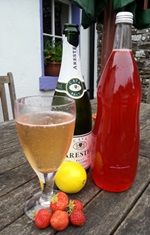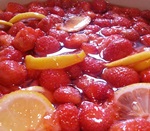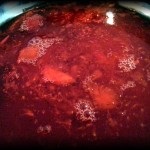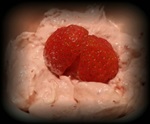
This post started out as a very simple but totally delicious, in season strawberry cordial recipe, as per the usual food blogging posts. However, as I was researching it and in particular the area of food sweeteners versus sugar, it became a lot more.

Strawberry Sensation (Strawberry Cordial & Cava)
The recipe for the very tasty summer drink is at the bottom of the post. If you don’t want to know about ASPARTAME just scroll down to the vibrant strawberry picture below and you’ll find it. I can’t recommend this strawberry cordial enough (if you have a supply of strawberries)! Seven out of seven people ranging across three generations loved it when I offered the first sips around the table here.
(If you’re growing strawberries and are looking for tips on looking after them or getting more out of your patch, here’s some older blog posts on them.)
But back to the Aspartame (*renamed AminoSweet®), why the concern?
We first heard about aspartame in the late 1980′s when it was linked with causing the symptoms of Gulf War Syndrome (‘Large quantities of aspartame sweetened diet soft drinks were provided to Gulf War troops, often times sitting in high temperature conditions. This artificial sweetener breaks down at roughly 85 °F (29.5 °C) into, among other things, methanol, formaldehyde, diketopiperazine and formic acid.’
However, it’s only in recent years since the arrival of our children, that we really started becoming concerned about the food we eat on a daily basis and have tried to cut the amount of artificial chemicals the family consume. It’s a personal choice for us to want to eat and drink food that’s been naturally produced – and by natural I mean from field to fork or well to tap. Luckily we’re in a place where the majority of the time we can do that. We’re by no means perfect, we have food stuff in our cupboards that contain additives and preservatives not considered ‘healthy’ but we’re working at it.
Having reduced the amount of pesticide and herbicide residues in our food by growing our own, we started to look at the rest of the ingredients in the cupboards. Would it surprise you to find that almost every cordial for sale in supermarkets has added sweeteners and in particular aspartame to make it ‘healthier’ and ‘sugar free’? I know I was. Having gazed at the row upon row of ‘fruit’ squashes in the larger and smaller local supermarkets, the only brand I’ve been able to find that doesn’t contain artificial sweeteners is Ribena. That’s it. A zillion and one choices yet only one ‘natural’ one? That can’t be a good start for our younger generations, the biggest consumers of squash I would imagine by far.
But we don’t want to consume sweeteners, we’re wary about them, even though they’re considered safe.
The official conclusion from the IFSA states that “The safety of aspartame has been extensively studied over the years and experts worldwide agree that aspartame is safe for use. This has been restated by the EU Scientific Committee for Food in 2002 and by EFSA in 2007 and 2009. In terms of the types of studies and the amounts given to human subjects in controlled studies, aspartame is one of the most thoroughly tested food additives. The approval of aspartame will continue to be kept under review by bodies such as the European Commission and EFSA as new scientific information becomes available. If this information shows that the conclusion that aspartame is safe for use is no longer valid, action will be taken immediately to review its authorisation.”
We’re supposed to be happy with the official line but it’s difficult. After years of being let down by authorities we’re supposed to trust, who do we believe? Call it old age or a natural cynicism but for over forty years there have been health concerns surrounding aspartame and many peer reviewed papers have been published collaborating those concerns. So why is there still an issue? If we’ve nothing to worry about as the IFSA suggests why are we still reading stories telling us that aspartame is dangerous, that it causes headaches, brain tumours, seizures and many more health issues?
Is it all about the money?
A post by Dr Jane Hull certainly makes you wonder (you can read it here.) In it she concludes that the Japanese owners of aspartame Ajinomoto, have invested over US$125 million into that one product alone. Would it not be disastrous for them if it were found to be unfit for human consumption? Would a company be willing to give up on a project they’ve invested so much into or would they lobby every power that be and pay scientists of their own to ‘research’ it and make sure that aspartame is considered safe?
* As a result of it’s unpopularity, Ajinomoto have rebranded aspartame and the Japanese “Pal Sweet Diet®” as “AminoSweet®” and replicated the 1982 American marketing campaign claiming that aspartame was all natural. (I’m curious to know how they can claim that having read the history of it.)
In light of all this uncertainty, we’ve chosen to avoid aspartame as much as we can, are buying Ribena with sugar and not sweeteners and are making our own real fruit drinks. These are being limited to mealtimes due to the quantity of sugar added to them and we’re trying to teach our kids the difference between real and artificial flavours in the hope that when they start buying food for themselves, they can do so having made informed choices.
What are your thoughts on aspartame? Does it bother you that it’s added to everything?
So now that’s covered, back to the scrummy strawberry cordial mentioned in the introduction with a link to another seasonal cordial recipe made from hedgerow elderflowers. Hope you enjoy making your own

Ingredients for Strawberry Cordial (makes just over 2 x 750ml bottles)
500g crushed strawberries
1 unwaxed lemon, thinly sliced
900g caster sugar
40g citric acid
500ml water

- Place the strawberries and lemon in a large glass bowl with the sugar and citric acid.
- Bring the water to the boil and once boiled, pour it into the bowl and stir until all the sugar has dissolved.
- Leave to cool, cover and place in a fridge for 4 days.
- Using a clean spoon, taste the concentrate to see if it is strong enough. If it requires further steeping, leave it in the fridge for another day or so.
- Strain through a sieve lined with muslin and decant into sterilised bottles. Keeps in the fridge for up to 6 months.
- When serving, dilute with still or sparkling water to taste.
For a very special drink for adults, dilute the cordial with Cava or sparkling wine and don’t plan on driving anywhere!

Lastly, if you’re feeling naughty, don’t discard the pulped strawberries. You can whisk them together with 250ml of double cream and fill a couple of meringue cases to make a quick but tasty dessert.

Dee Sewell – a horticulturalist and certified trainer who started Greenside Up in 2009 and teaches people how to grow vegetables. Dee specialises in working with community gardens but also offers workshops, allotment visits, consultations, horticultural therapy, afterschools clubs as well as local talks – she tailors her services to meet clients needs. In 2012 Dee launched a Seed Gift Collection containing varieties of vegetable and insect friendly flowers with the aim of getting more people growing. Dee’s blog was a finalist in the 2012 Ireland Blog Awards in the Eco/Green and Lifestyle Categories.
Source: Greenside Up – Strawberry Sensation or Alien Aspartame? – Dee Sewell





